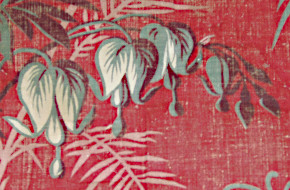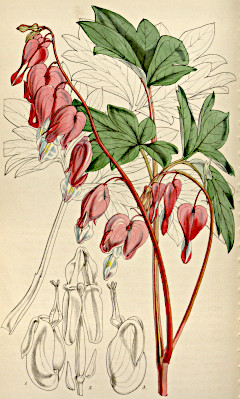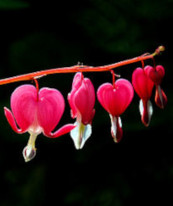Floral Motifs on Early Chintz
Lamprocapnos spectabilis- Bleeding Hearts



Lamprocapnos spectabilis (Bleeding Hearts) from Private Collection, Antique French Indiennes Pattern Quilt Fragment, nineteenth century
Lamprocapnos spectabilis (Bleeding Hearts) growing in a modern garden. Photo by flemming christiansen from hammer, denmark [CC BY-SA 2.0 (https://creativecommons.org/licenses/by-sa/2.0)], via Wikimedia Commons
Lamprocapnos spectabilis (Bleeding Hearts) (published as Dielytra spectabilis) from Curtis’s Botanical Magazine, t. 4417-4485, vol. 75 [ser. 3, vol. 5]: t. 4458 (1849)
Common Names: Bleeding Hearts, Bleeding-heart, Common Meeding Heart, Asian Bleeding-heart, Red-and-white Moutan-flower (in China)
Description: Lamprocapnos spectabilis (Bleeding Hearts) are members of the Poppy Family (Papaveraceae). The first specimens were introduced to England from Asia in the 1840s by the Scottish botanist and plant hunter Robert Fortune per Mary Gribbin & John Gribbin in their book Flower Hunters (Oxford, England: Oxford University Press, 2008), p. 214. However it must have been known in Europe earlier, either from botanical specimens or illustrations, as it was first named Fumaria spectabilis by Linnaeus in 1753 (www.wikidata.org/wiki/Q21874305).
Quilts with the above Anemone coronaria (Double Anemone) motif:
© Updated 12/31/2018 Author: Terry Terrell
Description: Lamprocapnos spectabilis (Bleeding Hearts) are members of the Poppy Family (Papaveraceae). The first specimens were introduced to England from Asia in the 1840s by the Scottish botanist and plant hunter Robert Fortune per Mary Gribbin & John Gribbin in their book Flower Hunters (Oxford, England: Oxford University Press, 2008), p. 214. However it must have been known in Europe earlier, either from botanical specimens or illustrations, as it was first named Fumaria spectabilis by Linnaeus in 1753 (www.wikidata.org/wiki/Q21874305).
Quilts with the above Anemone coronaria (Double Anemone) motif:
- Private Collection, Antique French Indiennes Pattern Quilt Fragment, nineteenth century
- None known at this time
© Updated 12/31/2018 Author: Terry Terrell